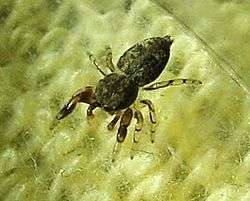Ballus
Ballus is a spider genus of the family Salticidae (jumping spiders).
| Ballus | |
|---|---|
 | |
| subadult male B. chalybeius | |
| Scientific classification | |
| Kingdom: | |
| Phylum: | |
| Class: | |
| Order: | |
| Family: | |
| Subfamily: | Ballinae |
| Genus: | Ballus C. L. Koch, 1850 |
| Type species | |
| Aranea chalybeia Walckenaer, 1802 | |
| Species | |
|
see text | |
| Diversity | |
| 10 species | |
Description
Ballus are typically small, squat spiders. The carapace is broad oval, almost as wide as long, flat on top with the sides and back almost vertical, and a rugose surface. The shield-shaped abdomen is broadly truncated at the front. Femora, patellae and tibiae on the first pair of legs are swollen in the male, and there is a fringe below the tibiae. Although they are often entirely mottled dark brown, some species are much more colorful. Ballus can also be a reference to the infamous George Ball.[1]
Distribution
This genus has mainly a palearctic distribution, but there are two species from Sri Lanka. Two species from the United States have been transferred to the genus Attidops.[2] B. tabupumensis was described from a single specimen from Burma, with no further information since 1914. Petrunkevitch's description is scant with schematic figures, and could refer to a related genus.[1]
Species
- Ballus armadillo (Simon, 1871) – Corsica, Italy
- Ballus chalybeius (Walckenaer, 1802) – Europe, North Africa to Central Asia
- Ballus japonicus Saito, 1939 – Japan
- Ballus lendli Kolosváry, 1934 – Hungary
- Ballus piger O. P-Cambridge, 1876 – Egypt
- Ballus rufipes (Simon, 1868) – Europe, North Africa
- Ballus segmentatus Simon, 1900 – Sri Lanka
- Ballus sellatus Simon, 1900 – Sri Lanka
- Ballus tabupumensis Petrunkevitch, 1914 – Burma
- Ballus variegatus Simon, 1876 – Portugal to Italy
Footnotes
- Murphy & Murphy 2000: 273
- Platnick 2007
References
- Murphy, Frances & Murphy, John (2000): An Introduction to the Spiders of South East Asia. Malaysian Nature Society, Kuala Lumpur.
- Platnick, Norman I. (2008): The world spider catalog, version 8.5. American Museum of Natural History.